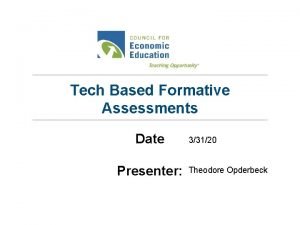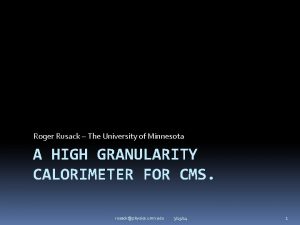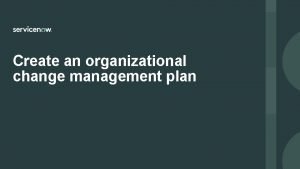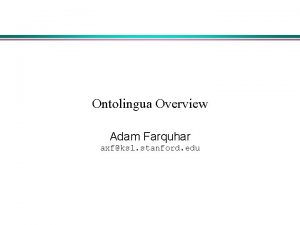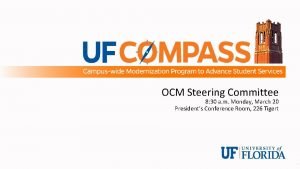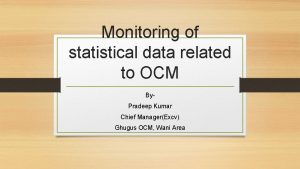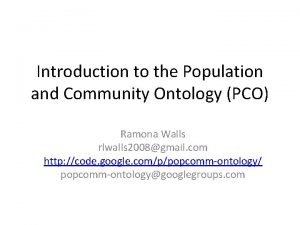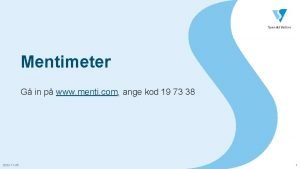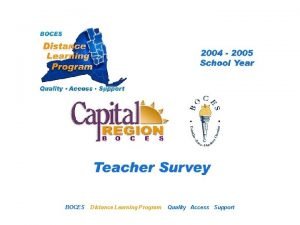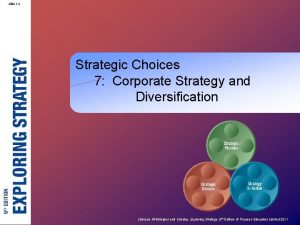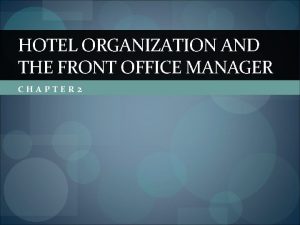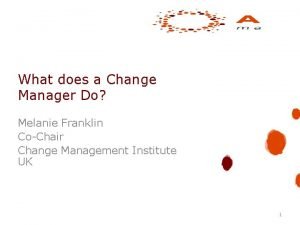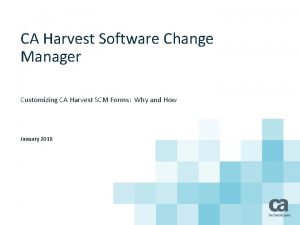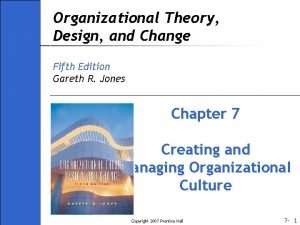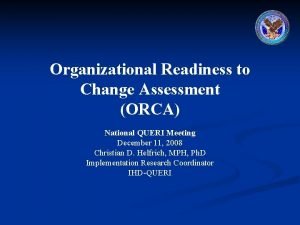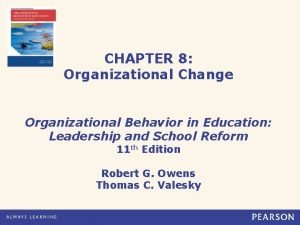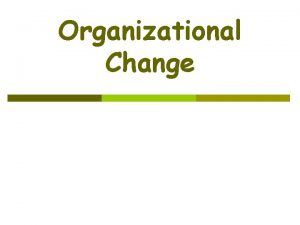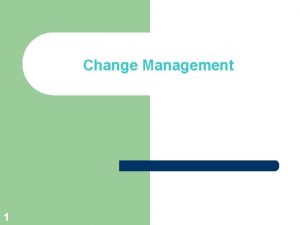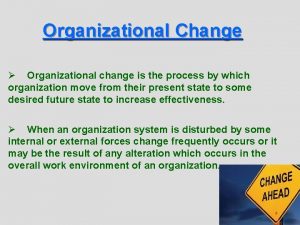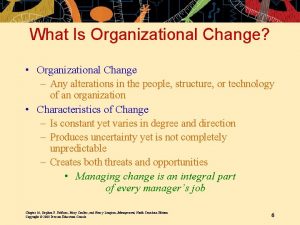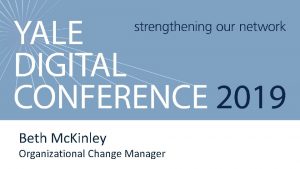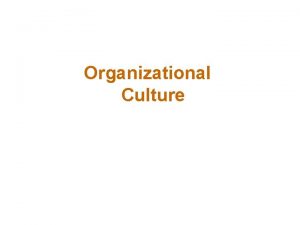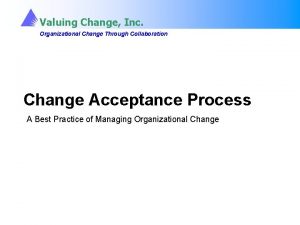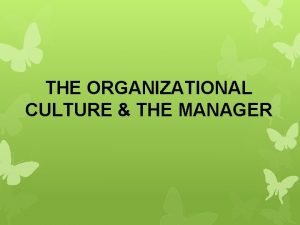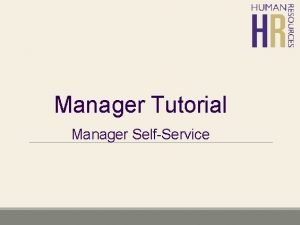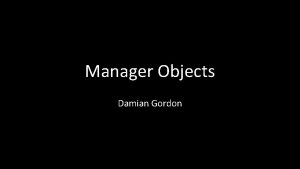Introduction to the Organizational Change Manager OCM National






















- Slides: 22

Introduction to the Organizational Change Manager (OCM) National QUERI Meeting December 12, 2008 Carmen Hall, RN, Ph. D Implementation Research Coordinator PT/BRI QUERI Adapted with permission from Harold J. Steudel Ph. D. Emerson Electric Professor in Total Quality Department of Industrial and Systems Engineering UW-Madison

Basic Tenets of Improvement n Every system is perfectly designed to achieve the results they achieve. n To change the results, the systems must be redesigned ---changed--- improved

1. Project Start OCM Research Model: The Four Phases of Change Initiatives 2. Problem Exploration 4. Solution Implementation & Testing Successful Change No 3. Solution Development Solution Plan Modify?

Purpose and Uses of the OCM n Predicts & explains success of projects & organizational readiness to change n Output: forecast, explanation, actions n 15 Factors (four questions per factor).

The 15 Factors in the OCM n Start n 9 Relative advantages 10 Funding 11 Flexibility of design 1 Project launch 2 Project champion 3 Senior leader support n Problem exploration 4 Middle Mgr. support 5 Staff needs & support 6 Tension for change 7 Problem exploration 8 External influence Solution development n Implementation & testing 12 Implement plan complexity 13 Staff changes required 14 Work environment 15 Testing & refinement

When is the OCM most often used? n Project n n Analysis At the Start While Underway After a Project Concludes Points beyond

How is the OCM most often used? n Organizational Analysis n Describe the Propensity to Change based on past experiences

Track OCM Score Changes over Time 4 3 2 1 0 -1 -2 -3 -4 OCM Score Selection Prob Exp Soln Dev Implement

Integrative Group Process Factor selection n Propose outcome definition n Select group of experts n Construct initial straw model (phone) n Revise straw model---retreat setting n Profiles to finalize model factors --- retreat

Integrative Group Process Model quantification n Assure factors are independent n Assign likelihood odd ratios to model factors– retreat setting n Identify sources of inconsistency in likelihood odd ratios ---retreat n Finalize likelihood odd ratios for the model– retreat n Assign a priori odds for model -- retreat Molfenter T. Prospective evaluation of a Bayesian Model to predict organizational change. Health Care Management 2005, 30 (3)

OCM Development n Fifteen factors identified by various experts in change management. n Subjective Bayesian Model based upon the state of the 15 factors in an organization: n n Predicts likelihood of success of projects Explains organizational readiness to change. n Research-based; tested in > 500 projects. n Predictive accuracy determined.

What does the OCM predict? What is success?


Prediction of Propensity for Successful Change Very High Success Chance of Project Success or Failure High Medium Failure Low Very Low -10 -5 -3 -1 0 1 3 OCM Predictor Score 5 10

Introduction to The OCM Scoring Guide Factor Project Launch Project Champion Linkage and Communicatio n Senior Leadership Level Yes No Project Start You and the Senior Leadership Team: 1 a. Carefully selected the project 1 b. Provided a very clear aim for the project 1 c. Indicated that not changing is unacceptable and set a firm deadline 1 d. Designated a champion(s) to make the project succeed Project champion: 2 a. Is very committed to making this project successful 2 b. Has substantial power to make things happen 2 c. Has substantial prestige in the organization 2 d. Shows respect for the involved staff 3 a. The project, if successful, will help the organization meet corporate goals 3 b. Mechanisms have been developed to keep leaders informed and involved 3 c. Leaders have endorsed the project in visible ways 3 d. Leaders have committed to spend their time & resources to remove obstacles when they arise in the project

Using the OCM Scoring Guide n Most common approach n n Each team member completes their OCM Scoring Guide individually to score each of the factors Requires 15 -20 minutes to complete after introduction All data are then entered into the OCM Program Alternate n n n Teams talk about each factor together to come to consensus; Yields one final answer (yes or no) for each of the factors to enter into the OCM Program; Requires about 60 – 90 minutes to complete as a group

The OCM Predictor Score: n Ranges in value from -10 to +10. n Portrays chances of project success n. Failure increases as the score approaches -10. n. Success increases as the score approaches +10. For example: A score of +7 means projects with this score succeed 7 times more frequently than they fail. A score of -8 means projects with this score fail 8 times more frequently than they succeed.

Using the OCM Program (software) Provides the OCM Scores (Process and Cultural Changes) and the Graphical Results: n 0. 65 <--- OCM Score for a Process Change -0. 55 <--- OCM Score for a Cultural Change

Next Steps n n n Feasibility & utility in VA implementation projects Collaborate with developers to address limitations Use and refine model

For more information contact: carmen. hall@va. gov Permission to use OCM within the VA has been provided by its developers, David H. Gustafson, Ph. D and Harold J. Steudel, Ph. D. Their collaboration and generosity are greatly appreciated.

OCM References… Gustafson, Edwards and Phillips "Subjective Probabilities in Medical Diagnosis, " IEEE Trans on Man-Machine Sys 10( 3), Sept 1969. Gustafson, Greist, Kestly and Jensen, "Initial Evaluation of Subjective Bayesian Diagnostic System, " Health Services Research, Fall, 1971. Gustafson, Cats-Baril & Alemi (1992) Systems to Support Health Policy Analysis, Health Administration Press. Gustafson, Sainfort, Johnson, Sateia, et al, “The Construction, Reliability, Validity, Application and Impact of a Quality Index for Psychiatric Emergency”, Health Services Research 28(2), 1993.

OCM References (continued) Gustafson D. , Sainfort F. , Eichler M. , Adams L. , Bisognano M. , and Steudel H. , The Developing and Testing a Model to Predict Outcomes of Organizational Change" Health Services Research, 38(2) 2003. Olsson J. “Factors Of Importance For Understanding Successful Improvement Initiatives In Swedish Health Care” [Tec Lic]. Göteborg, Sweden. Quality Sciences, Chalmers Institute of Technology; 2002. Olsson J. Øvretveit J. Kammerlind P. Developing And Testing A Model To Predict Outcomes Of Organizational Change. Quality Management in Health Care 12 (4) 2003.
 Gim kit live
Gim kit live Roger rusack
Roger rusack Monday.ocm
Monday.ocm Kahoot.it4
Kahoot.it4 Ocm plan
Ocm plan Ksl.ocm
Ksl.ocm Ocm uf
Ocm uf Hemmper
Hemmper Gmail.ocm
Gmail.ocm Menti.com suomi
Menti.com suomi Ocm boces blackboard login
Ocm boces blackboard login Ocm inversion 2021
Ocm inversion 2021 Senior manager vs general manager
Senior manager vs general manager Portfolio manager synergy manager parental developer
Portfolio manager synergy manager parental developer Organizational chart of front office department
Organizational chart of front office department What does a change manager do?
What does a change manager do? Harvest software change manager
Harvest software change manager Change adalah
Change adalah Development change adalah
Development change adalah Organizational theory design and change
Organizational theory design and change Organizational readiness to change assessment (orca) pdf
Organizational readiness to change assessment (orca) pdf Organizational change in education
Organizational change in education Organizational change and stress management
Organizational change and stress management
